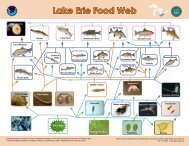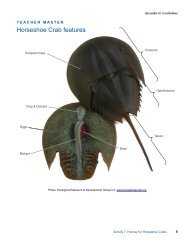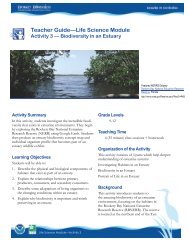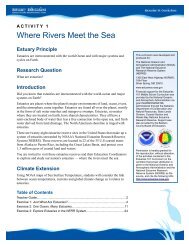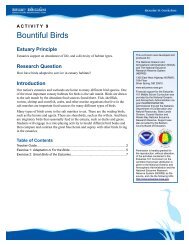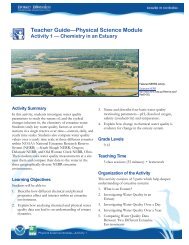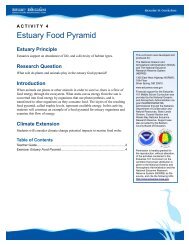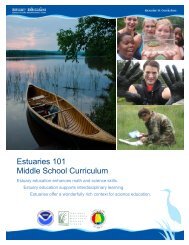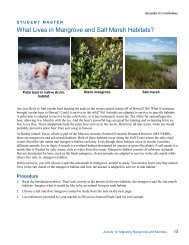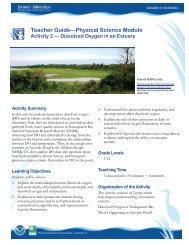Teacher GuideâEarth Science Module - Estuaries NOAA
Teacher GuideâEarth Science Module - Estuaries NOAA
Teacher GuideâEarth Science Module - Estuaries NOAA
You also want an ePaper? Increase the reach of your titles
YUMPU automatically turns print PDFs into web optimized ePapers that Google loves.
Student ReadingActivity 2: Estuarine Tides — It’s Not Just the Sun andMoonWhat Affects Tides in Addition to the Sun and Moon?The relative distances and positions of the sun, moon and Earth all affect the size and magnitude of theEarth’s two tidal bulges. At a smaller scale, the magnitude of tides can be strongly influenced by the shape ofthe shoreline. When oceanic tidal bulges hit wide continental margins, the height of the tides can be magnified.Conversely, mid-oceanic islands not near continental margins typically experience very small tides of 1 meter orless. The shape of bays and estuaries also can magnify the intensity of tides. Funnel-shaped bays in particular candramatically alter tidal magnitude. The Bay of Fundy in Nova Scotia is the classic example of this effect, and hasthe highest tides in the world—over 15 meters. Narrow inlets and shallow water also tend to dissipate incomingtides. Inland bays such as Laguna Madre, Texas, and Pamlico Sound, North Carolina, have areas classified asnon-tidal even though they have ocean inlets. In estuaries with strong tidal rivers, such as the Delaware River andColumbia River, powerful seasonal river flows in the spring can severely alter or mask the incoming tide. Localwind and weather patterns also can affect tides. Strong offshore winds can move water away from coastlines,exaggerating low tide exposures. Onshore winds may act to pile up water onto the shoreline, virtually eliminatinglow tide exposures. High-pressure systems can depress sea levels, leading to clear sunny days with exceptionallylow tides. Conversely, low-pressure systems that contribute to cloudy, rainy conditions typically are associatedwith tides that are much higher than predicted.— Adapted from <strong>NOAA</strong>’s National Ocean Service website, section on Tides &Water Levels.URL:http://oceanservice.noaa.gov/education/kits/tides/tides08_othereffects.html.Accessed: 2008-07-20. (Archived by WebCite ® at http://www.webcitation.org/5ZS2dFx8h)For a more thorough background on tides, see the NOS Tutorial on Tides and Water Levels:Earth <strong>Science</strong> <strong>Module</strong>—Activity 2



